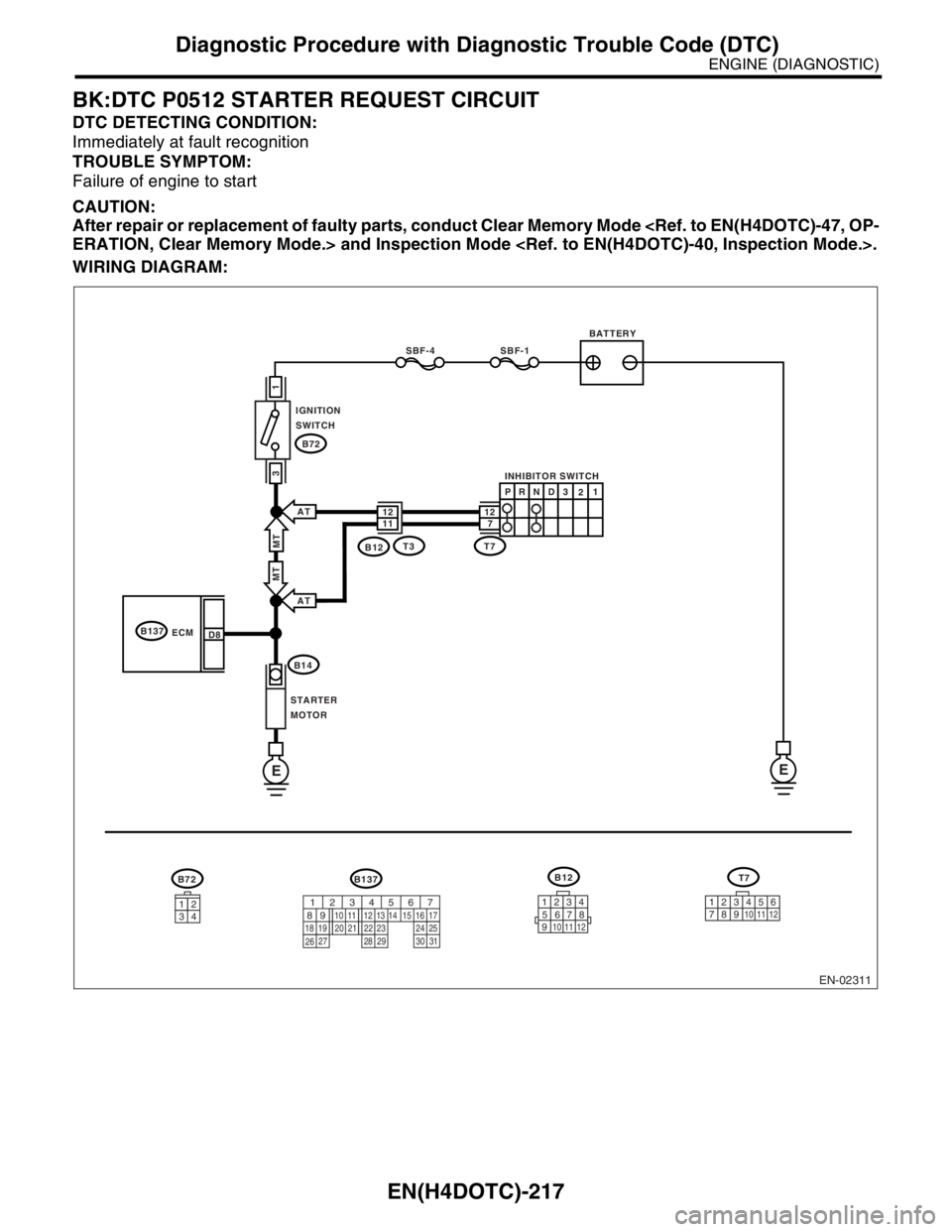2004 SUBARU FORESTER ignition
[x] Cancel search: ignitionPage 1845 of 2870

EN(H4DOTC)-212
ENGINE (DIAGNOSTIC)
Diagnostic Procedure with Diagnostic Trouble Code (DTC)
Step Check Yes No
1 CHECK ANY OTHER DTC ON DISPLAY.Is any other DTC displayed? Inspect the rele-
vant DTC using
“List of Diagnostic
Trouble Code
(DTC)”.
List of Diagnostic
Trouble Code
(DTC).>
N
OTE:
In this case, it is
not necessary to
inspect DTC
P0507.Go to step 2.
2 CHECK THROTTLE CABLE.Does the throttle cable have
play for adjustment?Go to step 3.Adjust throttle
cable.
INSTALLATION,
Accelerator Con-
trol Cable.>
3 CHECK AIR INTAKE SYSTEM.
1) Turn the ignition switch to ON.
2) Start and idle the engine.
3) Check the following items:
Loose installation of intake manifold, idle air
control solenoid valve and throttle body
Cracks of intake manifold gasket, idle air
control solenoid valve gasket and throttle body
gasket
Disconnections of vacuum hosesIs there any fault in air intake
system?Repair air suction
and leaks.Replace the idle
air control solenoid
valve.
Idle Air Control
Solenoid Valve.>
Page 1847 of 2870

EN(H4DOTC)-214
ENGINE (DIAGNOSTIC)
Diagnostic Procedure with Diagnostic Trouble Code (DTC)
Step Check Yes No
1 CHECK OUTPUT SIGNAL FROM ECM.
1) Turn the ignition switch to ON.
2) Measure the voltage between ECM and
chassis ground.
Connector & terminal
(B134) No. 27 (+) — Chassis ground (
−):Is the voltage more than 3 V? Repair the poor
contact in ECM
connector.Go to step 2.
2 CHECK POWER SUPPLY TO IDLE AIR CON-
TROL SOLENOID VALVE.
1) Turn the ignition switch to OFF.
2) Disconnect the connector from idle air con-
trol solenoid valve.
3) Turn the ignition switch to ON.
4) Measure the voltage between idle air con-
trol solenoid valve and engine ground.
Connector & terminal
(E7) No. 2 (+) — Engine ground (
−):Is the voltage more than 10 V? Go to step 3.Repair the har-
ness and connec-
tor.
N
OTE:
In this case repair
the following:
Open circuit in
harness between
idle air control
solenoid valve and
main relay connec-
tor
Poor contact in
coupling connector
3 CHECK HARNESS BETWEEN ECM AND
IDLE AIR CONTROL SOLENOID VALVE
CONNECTOR.
1) Turn the ignition switch to OFF.
2) Disconnect the connector from ECM.
3) Measure the resistance of harness
between ECM and idle air control solenoid
valve connector.
Connector & terminal
(B134) No. 27 — (E7) No. 1:Is the resistance less than 1
Ω?Go to step 4.Repair the har-
ness and connec-
tor.
N
OTE:
In this case repair
the following:
Open circuit in
harness between
ECM and idle air
control solenoid
valve connector
Poor contact in
coupling connector
4 CHECK HARNESS BETWEEN ECM AND
IDLE AIR CONTROL SOLENOID VALVE
CONNECTOR.
Measure the resistance of harness between
ECM and chassis ground.
Connector & terminal
(B134) No. 10 — Chassis ground:Is the resistance more than 1
MΩ?Go to step 5.Repair ground
short circuit in har-
ness between
ECM and idle air
control solenoid
valve connector.
5 CHECK GROUND CIRCUIT OF IDLE AIR
CONTROL SOLENOID VALVE.
Measure the resistance of harness between
idle air control solenoid valve connector and
engine ground.
Connector & terminal
(E7) No. 3 — Engine ground:Is the resistance less than 5
Ω?Go to step 6.Repair open circuit
in harness
between idle air
control solenoid
valve connector
and engine ground
cable.
6 CHECK POOR CONTACT.
Check poor contact in ECM and idle air control
solenoid valve connectors. Is there poor contact in ECM
and idle air control solenoid
valve connectors?Repair poor con-
tact in ECM and
idle air control
solenoid valve
connectors.Replace the idle
air control solenoid
valve.
Idle Air Control
Solenoid Valve.>
Page 1849 of 2870

EN(H4DOTC)-216
ENGINE (DIAGNOSTIC)
Diagnostic Procedure with Diagnostic Trouble Code (DTC)
Step Check Yes No
1 CHECK THROTTLE CABLE.Does the throttle cable have
play for adjustment?Go to step 2.Adjust throttle
cable.
Accelerator Con-
trol Cable.>
2 CHECK OUTPUT SIGNAL FROM ECM.
1) Turn the ignition switch to ON.
2) Measure the voltage between ECM and
chassis ground.
Connector & terminal
(B134) No. 27 (+) — Chassis ground (
−):Is the voltage more than 10 V? Go to step 3.Go to step 4.
3 CHECK OUTPUT SIGNAL FROM ECM.
1) Turn the ignition switch to OFF.
2) Disconnect the connector from idle air con-
trol solenoid valve.
3) Turn the ignition switch to ON.
4) Measure the voltage between ECM and
chassis ground.
Connector & terminal
(B134) No. 27 (+) — Chassis ground (
−):Is the voltage more than 10 V? Repair battery
short circuit in har-
ness between
ECM and idle air
control solenoid
valve connec-
tor.After repair,
replace the ECM.
Engine Control
Module (ECM).>Replace the idle
air control solenoid
valve and ECM.
Idle Air Control
Solenoid Valve.>
Engine Control
Module (ECM).>
4 CHECK OUTPUT SIGNAL FROM ECM.
Measure the voltage between ECM and chas-
sis ground.
Connector & terminal
(B134) No. 27 (+) — Chassis ground (
−):Does the voltage change by
shaking the harness and con-
nector of ECM while monitor-
ing the value with voltage
meter?Repair battery
short circuit in har-
ness between
ECM and idle air
control solenoid
valve connec-
tor.After repair,
replace the ECM.
Engine Control
Module (ECM).>Contact the SUB-
ARU dealer.
N
OTE:
Inspection by DTM
is required, be-
cause probable
cause is deteriora-
tion of multiple
parts.
Page 1850 of 2870

EN(H4DOTC)-217
ENGINE (DIAGNOSTIC)
Diagnostic Procedure with Diagnostic Trouble Code (DTC)
BK:DTC P0512 STARTER REQUEST CIRCUIT
DTC DETECTING CONDITION:
Immediately at fault recognition
TROUBLE SYMPTOM:
Failure of engine to start
CAUTION:
After repair or replacement of faulty parts, conduct Clear Memory Mode
WIRING DIAGRAM:
EN-02311
BATTERY
INHIBITOR SWITCH
IGNITION
SWITCH
STARTER
MOTOR
SBF-4SBF-1
B72
B72
B14
B137
ECM
EE
1
3
D8
3412
B137
T3B12MT
AT
AT
MT
1112712
PR
N
D3
21
T7
B12
123
8
9
10
4
11
1256
7
T7
123
8910411 1256
7567
82 1
94 310
22 23 11 12 13 14 15
24 25
2616 17
18 19 20 21
27 28 29 30 31
Page 1851 of 2870

EN(H4DOTC)-218
ENGINE (DIAGNOSTIC)
Diagnostic Procedure with Diagnostic Trouble Code (DTC)
Step Check Yes No
1 CHECK OPERATION OF STARTER MOTOR.Does the starter motor operate
when ignition switch to ON?Repair battery
short circuit in
starter motor cir-
cuit.After repair,
replace the ECM.
Engine Control
Module (ECM).>Check starter
motor circuit.
60, STARTER
MOTOR CIR-
CUIT, Diagnostics
for Engine Start-
ing Failure.>
Page 1853 of 2870

EN(H4DOTC)-220
ENGINE (DIAGNOSTIC)
Diagnostic Procedure with Diagnostic Trouble Code (DTC)
Step Check Yes No
1 CHECK ANY OTHER DTC ON DISPLAY.Is any other DTC displayed? Inspect the rele-
vant DTC using
“List of Diagnostic
Trouble Code
(DTC)”.
List of Diagnostic
Trouble Code
(DTC).>
N
OTE:
In this case, it is
not necessary to
inspect DTC
P0519.Go to step 2.
2 CHECK AIR INTAKE SYSTEM.
1) Turn the ignition switch to ON.
2) Start and idle the engine.
3) Check the following items:
Loose installation of intake manifold, idle air
control solenoid valve and throttle body
Cracks of intake manifold gasket, idle air
control solenoid valve gasket and throttle body
gasket
Disconnections of vacuum hosesIs there any fault in air intake
system?Repair air suction
and leaks.Go to step 3.
3 CHECK THROTTLE CABLE.Does the throttle cable have
play for adjustment?Go to step 4.Adjust throttle
cable.
INSTALLATION,
Accelerator Con-
trol Cable.>
4 CHECK AIR BY-PASS LINE.
1) Turn the ignition switch to OFF.
2) Remove the idle air control solenoid valve
from the throttle body.
3) Confirm that there are no foreign particles
in by-pass air line.Are foreign particles in by-pass
air line?Remove foreign
particles from by-
pass air line.Replace the idle
air control solenoid
valve.
Idle Air Control
Solenoid Valve.>
Page 1855 of 2870

EN(H4DOTC)-222
ENGINE (DIAGNOSTIC)
Diagnostic Procedure with Diagnostic Trouble Code (DTC)
Step Check Yes No
1 CHECK CURRENT DATA.
1) Start the engine.
2) Read the data of exhaust temperature sen-
sor signal using Subaru Select Monitor or
OBD-II general scan tool.
N
OTE:
Subaru Select Monitor
For detailed operation procedure, refer to
“READ CURRENT DATA SHOWN ON DIS-
PLAY FOR ENGINE”.
OBD-II general scan tool
For detailed operation procedures, refer to the
OBD-II General Scan Tool Operation Manual.Is engine coolant temperature
more than 1200°C (2192°F)?Go to step 2.Repair the poor
contact.
N
OTE:
In this case repair
the following:
Poor contact of
exhaust tempera-
ture sensor
Poor contact in
ECM
Poor contact in
joint connector
2 CHECK HARNESS BETWEEN EXHAUST
TEMPERATURE SENSOR AND ECM CON-
NECTOR.
1) Turn the ignition switch to OFF.
2) Disconnect the connector from exhaust
temperature sensor.
3) Turn the ignition switch to ON.
4) Read the data of exhaust temperature sen-
sor signal using Subaru Select Monitor or
OBD-II general scan tool.
N
OTE:
Subaru Select Monitor
For detailed operation procedure, refer to
“READ CURRENT DATA SHOWN ON DIS-
PLAY FOR ENGINE”.
OBD-II general scan tool
For detailed operation procedures, refer to the
OBD-II General Scan Tool Operation Manual.Is the temperature less than
372°C (702°F)?Replace the
exhaust tempera-
ture sensor.
49, Exhaust Tem-
perature Sensor.>Repair ground
short circuit in har-
ness between
exhaust tempera-
ture sensor and
ECM connector.
Page 1857 of 2870

EN(H4DOTC)-224
ENGINE (DIAGNOSTIC)
Diagnostic Procedure with Diagnostic Trouble Code (DTC)
Step Check Yes No
1 CHECK CURRENT DATA.
1) Start the engine.
2) Read the data of exhaust temperature sen-
sor signal using Subaru Select Monitor or
OBD-II general scan tool.
N
OTE:
Subaru Select Monitor
For detailed operation procedure, refer to
“READ CURRENT DATA SHOWN ON DIS-
PLAY FOR ENGINE”.
OBD-II general scan tool
For detailed operation procedures, refer to the
OBD-II General Scan Tool Operation Manual.Is the temperature less than
372°C (702°F)?Go to step 2.Repair the poor
contact.
N
OTE:
In this case repair
the following:
Poor contact of
exhaust tempera-
ture sensor
Poor contact in
ECM
Poor contact in
joint connector
2 CHECK HARNESS BETWEEN EXHAUST
TEMPERATURE SENSOR AND ECM CON-
NECTOR.
1) Turn the ignition switch to OFF.
2) Disconnect the connector from exhaust
temperature sensor.
3) Measure the voltage between exhaust tem-
perature sensor connector and engine ground.
Connector & terminal
(B279) No. 1 (+) — Engine ground (
−):Is the voltage more than 10 V? Repair battery
short circuit in har-
ness between
ECM and exhaust
temperature sen-
sor connector.Go to step 3.
3 CHECK HARNESS BETWEEN EXHAUST
TEMPERATURE SENSOR AND ECM CON-
NECTOR.
1) Turn the ignition switch to ON.
2) Measure the voltage between exhaust tem-
perature sensor connector and engine ground.
Connector & terminal
(B279) No. 1 (+) — Engine ground (
−):Is the voltage more than 10 V? Repair battery
short circuit in har-
ness between
ECM and exhaust
temperature sen-
sor connector.Go to step 4.
4 CHECK HARNESS BETWEEN EXHAUST
TEMPERATURE SENSOR AND ECM CON-
NECTOR.
Measure the voltage between exhaust temper-
ature sensor connector and engine ground.
Connector & terminal
(B279) No. 1 (+) — Engine ground (
−):Is the voltage more than 4 V? Go to step 5.Repair the har-
ness and connec-
tor.
NOTE:
In this case repair
the following:
Open circuit in
harness between
ECM and exhaust
temperature sen-
sor connector
Poor contact of
exhaust tempera-
ture sensor con-
nector
Poor contact in
ECM connector.
Poor contact in
joint connector